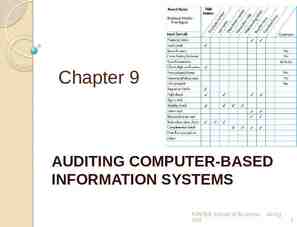Quick Breads Intro to Foods and Nutrition
7 Slides388.34 KB
Quick Breads Intro to Foods and Nutrition
Quick Breads Quick breads are flour mixtures. They include many different kinds of breads which differ greatly in flavor, size and shape, and general appearance. All of them can be made quickly and served piping hot. They are made with a variety of fast-acting leavening agents. That is why they are called Quick Breads.
Quick Bread Grouping There are three types of quick breads: 1. Pour batters: thin in consistency, these can be “poured” from the mixing bowl. They may contain equal amounts or close to equal amounts of liquid to flour ratio. Ex) waffles, pancakes, popovers. RATIO 1:1 2. Drop batters: are fairly thick and need to be scraped from the bowl into the baking pan. They usually contain twice as much flour as liquid. Ex) Muffins, biscuits, quick loaf breads and coffee cakes. RATIO 2:1 3.Soft dough: is thick enough to roll and shape by hand. It contains about three times as much flour as liquid. Ex) biscuits, doughnuts, scones and some coffee cakes. RATIO 3:1
Ingredients and Nutrients All quick breads contain most of these basic ingredients: 1. Flour- Structure 2. Leavening agents-rise and become light and porous 3. Salt- Flavor 4. Fat- Tenderness 5. Liquid- Activates the leavening agents and dissolves ingredients 6. Egg-Color, flavor and nutrients 7. Sugar-Sweetness and browning
Leavening agents for Quick Breads 1. Air 2. Steam 3.Chemical-CO2 Baking soda and Baking powder
Gluten When you mix flour with water you form GLUTEN. GLUTEN gives strength and elasticity to the batter or dough and will retain the air, steam or carbon dioxide so that the bread can increase in volume. If you over mix and handle quick breads too much, a large amount of gluten is developed and breads become tough.
Quick Bread Preparation There are three basic methods to mixing quick breads: 1.The MUFFIN METHOD: Used for muffins, waffles, griddle cakes, popovers and fruit and nut breads. Mix dry ingredients (sometimes sift) in a bowl and make a well Combine the liquid (separately) Pour liquids into the well of dry ingredients Mix to combine ingredients until just moistened Scrap from bowl into pan Bake until golden brown with rounded top, slight cracking on top and no tunnels 2. The BISCUIT METHOD: Sift together dry ingredients Cut fat into the flour mixture using a pastry blender Add liquid all at once and combine Turn dough out and knead. Roll dough flat Use a floured biscuit cutter to cut biscuits Bake on an ungreased cookie sheets until golden brown with a flat top and symmetrical 3. The CONVENTIONAL METHOD: Cream together fat and sugars Add eggs Alternate addition of dry and liquid ingredients












